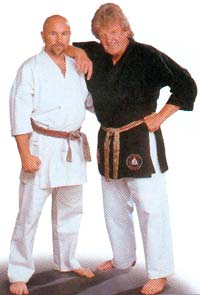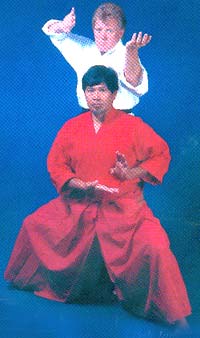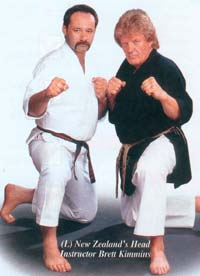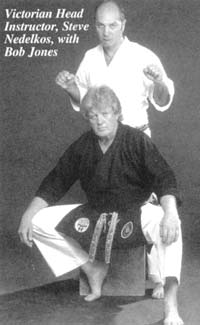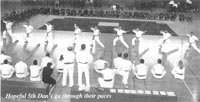30 years of Zen Do Kai...Part 1
Interview in Blitz Magazine - Vol. 15 No.1
by Mark Castignini
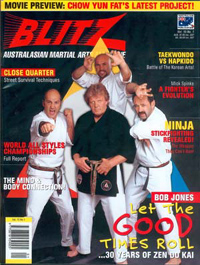 Bob Jones is one of the pioneers of martial arts in Australia and has come along way in 30 years.
Bob Jones is one of the pioneers of martial arts in Australia and has come along way in 30 years.
Mark Castagnini caught up with the founder of the Bob Jones Corporation (BJC) to congratulate him on his 30th anniversary and throw a few curly questions his way.
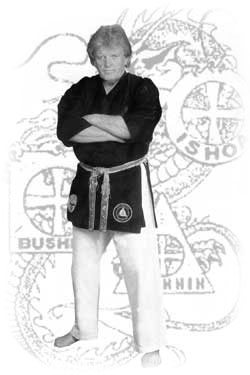 MC: Bob, congratulations on the establishment of one of Australia''s most successful martial arts organisations. What has been your most memorable moment during the past 30 years?
MC: Bob, congratulations on the establishment of one of Australia''s most successful martial arts organisations. What has been your most memorable moment during the past 30 years?BJ: Anyone who really knows me, knows I am not the kind of person to dwell on the past. I try not to oversleep (which means never); five to six hours sleep is enough for me. The rest of the time is spent helping all my instructors to put the big picture together, which is like creating this big jigsaw puzzle with many of the pieces having to be handmade. My 30 years (really 35 years counting my coloured belts since 1965) martial arts career has afforded me a million wonderful memories (which by the way I am writing a series of books about).
My most recent memory, which gives me most pride, was the Victorian State Gradings for the end of year 2000 and our 30th year annual ball. Wow! What a day and what a night. Our largest ever blackbelt gradings, with so many 5th, 4th, 3rd degrees and so many browns to black and second degrees (The Zen Do Kai Marathon). I wouldn''t mind betting it could have been a world first. I personally don''t know any style to grade that many in one day.
(Check out www.zendokai.com.au)
That night, as always, the evening was sold out. BJC representatives had come from all over New Zealand and every state of Australia for a week of positivity and planning for 2001. That night we had banded together, with only one thing on our minds, and that was to let the good times roll. And we did.
MC: Tell us about the formative years. Memories of training in those early days?
BJ: On March 3, 1965, I entered the East St.Kilda training hall at the rear of the post office. Jack Rozinsky put me through two hours of hell. This was the day 1 met the crossroads of my life. I had been almost totally undisciplined up to this point in time. Jack introduced me to the way (the path) of the martial arts.
Through his Tae Kwon Do training I saw a self discipline that would create such a positivity that I would imagine anything to be possible. He sparked within me the concept that if you can conceive and believe... you will achieve. Jack Rozinsky''s classes were raw, tough, he expected and demanded only the best of every student in every class. Many years after I remember trying to make my blackbelt classes as physically demanding as Jack''s pioneering training sessions.
From the Korean style of Tae Kwon Do, I then continued this martial arts journey with Tino Ceberano and his Japanese Goju Kai style. Tino''s popularity had him expanding into new clubs at an incredible rate. Within one month I was a white belt helping teach beginners and feeding them onto Tino in the advanced white belt classes. Tino taught all of us advanced white belts on Saturdays at the Goju Kai Canterbury headquarters, then every weeknight, we were out there in the suburbs teaching the Goju gospel.
Some time later my teaching skills earned me my first green tags ...then another two green tags ...and then later still, yet another two green tags on my white belt. Then those beginners would look at me in awe, with my six green tips and I''d sense them thinking `Wow, if only I can make it that far, one day''.
My next experience on this martial arts journey came years later as a brown belt, when Sal Ebanez arrived on the scene. He came in the guise of a short, bald, fat man and taught me one of my major lessons about being a man among men. You cannot judge a book merely by its cover. To really learn from a book you must go into its pages one chapter at a time. He taught me that the softest gentlest man, could also be one of the most powerful. Training with Sal Ebanez, I saw that there really was a light at the end of the tunnel. The knowledge of the martial arts really was through the other side?just waiting to be found and explored.

MC: To what do you attribute your success and the growth of the BJC?
BJ: A large part of my success is due to my grounding, the grass roots of my three initial instructors giving me a strong base. Due to each of them I was able to build myself a foundation that today has produced a martial arts empire of more than a thousand clubs. My personal logo tells the story by having the three primary colours of red, yellow and blue within a triangle surrounding a white circle. At first viewing you would be correct if you interpreted the colours, being mixed in perfect proportions as producing the white circle of karma. Any of the three primaries mixed even slightly out of balance ventures off into many varied colours, symbolically giving us strength in only certain areas. Endeavouring to balance the three primaries along our journey is the way to experience the vision of the white tunnel to seek out the truth while exploring the martial arts way.

"Due to each of them I was able to build myself a foundation that today
has produced a martial arts empire of more than 1000 clubs"
Jack Rozinsky (Red Physical) taught me to channel aggression that for every day of hard work comes a day of good pay was not necessarily about money.
Tino Ceberano (Yellow Psychological) taught me above all to have respect for rank within the martial arts. I might not like the person wearing the belt, but it is the `belt they wear'' that guides us along the way. Through Tino I also saw a way to mass produce the clubs something as good as our martial arts philosophy should be for everyone, not just a few.
Sal Ebanez (Blue Spiritual) gave me three principles to help me balance my colours: Never set myself up to be a judge of others; The way of a group leader is to lead by group example ...
And lastly, if you want respect, you have to first give respect.
I was given this information during the five years prior to 1970, this gave me the people skills and my work in security gave me the people. Martial arts, Bob Jones, the security industry and people just started coming together ...on mass. Nationwide we took over security of pubs and clubs. We did everything, major outdoor rock festivals and we toured the world with every major rock act as the bodyguards. Nationwide I just kept opening more and more Bob Jones clubs until now there are well over one thousand in Australia and New Zealand.
MC: Bob, can you explain the evolution the BJC has undertaken: The changes fighting systems and techniques and how they have progressed?
|
Charlie Kambouris with Bob Jones |
BJ: The last question explained the grow of the BJC the biggest advantage of building such a large empire where we have mass communication with all kinds of people from all walks of life ...feedback! Twenty years of myself, Richard Norton, Noel Rush, Tony Quinn and dozens of other blackbelts travelling the world as bodyguards. More than 30 years myself, Stan `the Man'' Longinidis hundreds of kickboxers travelling the world as competitors. All of this kept the BJC abreast of trends anywhere in the world as they happen sometimes even before. I always knew that to become the biggest and remain out in front, BJC would need room to change and evolve. With the influence of every BJC black belt as far the 1970s always working in security there has, since day dot, been the philosophy that if it works use it, if it doesn''t work, put it aside until your understanding of the arts has more depth.
Thus simple and practical techniques we always prescind.
From a wild adolescence of gang days our ethnic population explosion due to our Prime Minister of that era offering a one way ten pound (the equivalent then of 20 dollars) passage from Europe to Australia, to running of a Sly Grog establishment prior to extension of 6pm (Liquor laws every closed at 6pm), to my very violent bouncing escapades of the ''60s , this 20 years of street smarts gave the BJC advantage over opposition dojos.
Plus, from the beginning we boxed, played Judo, wrestled and always made plenty of contact as a part of character development. Severe and multiple injuries had us finally don boxing gloves and kick with shin pads and boot pads. A trip to Thailand (12 trips in 10 years) introduced us to new rules that allowed us to get rid of all the padding and at the same time more weapons. The Thai style stand up grappling proved so effective, it led us to ground fighting of course we went to the best to the best of Brazilian grappling.
From Australia''s violent past and our disgusting abuse of indigenous people, to the British enslavement of Welsh, Scottish and mostly Irish prisoners, to the days when `bare knuckle boxing'' was this country''s most popular sport. Major world wars with Japan, Korea and Vietnam would expose their ancient Asian fighting arts to the western world. Currently we are borrowing from the Philippines their Escrima Kali techniques, as sadly sticks and knives are becoming more prevalent within our society''s violence. Along with this little romp through history ...the most exciting thing I discovered recently (since 1990) was my own Celtic heritage, now I read everything I can find on Celtic literature and as I acquire this literature of the ancients and the millenniums change, I find myself more at peace with myself as a martial artist.
|
Two Masters, |
MC: Do you believe that martial arts training is as tough as it was 20 years ago? What do you perceive to be the main differences in training styles today as compared to yesteryear?
BJ: This is often the first question I get all the time and it still pisses me off. Put simply, you get out of martial arts what you put in. This bullshit of olden times being the tough old days is just that ...bull! Just prior to this coming Christmas, the BJC had gradings in all regions of Australia and all over New Zealand. I saw literally hundreds of brownbelts traded for ShodanHo (The First Step) and as many again, maturing blackbelts trading their current degree for one higher. Now, I do not judge a father in his late 40s who has been recommended after two heart by passes by his doctor to take up Zen Do Kai with his two teenage sons.
I don''t sit in judgement of the sole parent mother in her late 30s carrying those extra unwanted kilos as a result of childbirth she''s desperate to learn self defence because even the cops can''t do anything about her drunken ex who comes home just long enough to beat on her and her kids.
I don''t even pass judgement on the 18 year old who fell off his motorbike and was told by his physio that receiving his brownbelt would improve the coordination of his new limbs above all else. So you don''t think martial arts training would be tough on these guys. Okay, how about you get your weight up to 110kgs and train to take on Peter Aerts at the next K1 or Sam Greco in the WCW. Perhaps you''d prefer the next UFC against Maurice Smith or one of the Machados or Gracies. Then again you could weigh in around 80kgs against Paul Briggs whose new boxing career has him knocking out Australia''s best boxers. Yes, I remember the good old days when we were all first, second and third degrees.
Answering question one I said anyone who really knows me, knows I am not the kind of person who dwells on the past. I have far too much work (plus my own personal training) to prepare for my next grading in 2003. That will be eight years since I took seventh degree. The BJC expects that when the number of years coincide with the number of the next degree you do it! Zen Do Kai''s 8th Degree states that we must break our world down and replace it back in in its correct constituents. Who ever it was that said it was tough 20 years ago, I''d like to punch you!
The major difference between training today and 20 years gone is knowledge. You are cheating your students and worse, yourself, if you do not travel and do the seminars. There is so much knowledge out there these days. You have to cross style train, no one style has all the answers. One other thing about the students of today ...they expect you to be their friend as well as instructor. In today''s self defence market you have to be more approachable, more accessible.
|
New Zealand''s Head Instructor |
MC: Who has had the most influence over Bob Jones throughout the years and who do you admire most outside the BJC.
BJ: During the late 50''s and early 60''s, I was constantly attracted to magazine articles, daily newspapers and television exposure about these amazing blackbelts in Sydney and their escapades. I remember first thinking "I wonder what" and secondly "how" these Sydney guys became blackbelts in this new karate craze. That was just a decade after the Japanese World War and Australia had just returned from the Korean war. It would be another 20 years before Vietnam, thus my questions: "what?" and "how?".
The very first person I ever knew as any sort of `blackbelt'' was Joe Miessner. Joe was tall (two metres six foot plus), good looking, reputed to be one of the strongest (via weightlifting) teenagers ever to come out of Bendigo, Victoria.
Now in his late 20s in Sydney, he was a definite celebrity who got all the girls whether they aspired to be movie stars or hookers. A self promoted `first time ever'' world champion (by winning a Japanese tournament) was taken to task and debated by Mike Willisee on a national Current Affair show. The second blackbelt of notoriety at this time was Fred Vella. He first hit the national media by demolishing a whole house in Karate Gi no padding or protection of any kind he chopped and kicked the whole house down with bare hands and feet. Fred was equally as good looking as Joe and both men were strikingly handsome. Both of them were naturals to be action plus Karate movie stars, what a pity no one thought of it at the time.
After I got my black belt and ventured into Sydney in my role as a bodyguard to the rich and famous rock stars Joe and Fred and I became buddies (this makes for good reading in my series of books, this one entitled `The Greatest Story Never Told''). One of them went to prison for attempting to borrow a bunch of MI6''s from the NSW''s army base ...and the other always argues with me that the BJC in .martial arts does it all wrong.
1963
I can''t believe it! Thursday, August 25 at 1pm. "Live": Martial Arts Expert in Karate, Kendo and Aikido at the Melbourne Sports Depot. Famous American author, (Don Draeger) lives in Japan, speaks fluent Japanese, has beautiful Japanese wife...One appearance only...Come and see him. He will be signing copies of his new book that can be purchased at this demonstration.
At 46years of age he looked more like 26. Bare topped, wearing only a black hakama, he moves with the grace and fluidity of a python while seemingly he contained the power of a panther, As he sliced the air with double swords, the long Katana and the short Wakizashi. I was spellbound, mesmerised, I had never seen anything like this. All I knew was somehow, someway, someday this was going to be me. Out of the hundreds of people at this demonstration at the Melbourne Sports Depot, I''m not sure if he sensed the effect he had on me, or if instinctively knew August 25 was my birthday. Either way he scribbled something inside the cover of his latest book and said
"Here, this is from me to you, consider it a gift."
On the way home I realised that I had not said hello, thank you or anything at all. When I got home I looked at what he had written inside the book.
"When you see a worthy person, endeavour to emulate him. When you see an unworthy person, take a closer look at your inner self."
It was signed "From your Guide" along with his signature. It would be 18 months of serious searching before I would find Mr Jack Rozinsky and begin my journey that so many others would follow.
1972
|
Victorian Head Instructor, |
In six months extensive training and competing in Canada and North America, I met, trained and/or fought the best: Peter Urban, Aaron Banks, Mike Anderson, Steve Armstrong (10th Degree), Jimmy Jones (BKF Tournament Promoter), Tadashi Yamashita, Fumio Demura, Joe Lewis, Chuck Norris, Howard Jackson, Pat Johnson, Skipper Mullins, Ken Knudson, Joel Ward (he beat me in Chicago), John Nativitad, "Super"'' Dan Anderson (he beat me once, I beat him twice) and the list goes on. Hundreds of fabulous martial artists who were an influence on me in the ''70s. One name in this era does stand out as a major influence on me (I was 2nd degree at this time), "Mr Unbeatable" Mike Stone (Mike was the reason Prescilla and Elvis went separate ways). Mike was my major instructor during the American Tour of Duty in 1972.
While training with Mike I often worked out with one of his green belts whose name was Howard Hanson. In a couple of years Howard would become the founder of the WKA, which would soon be the first worldwide kickboxing organisation sanctioning fights in Japan and Europe. Hanson gave me the reigns for the WKA South Pacific Region in 1976.
Kickboxing during the ''70s and ''80s, I was strongly influenced by Benny `The Jet'' Urquidez, Don `The Dragon'' Wilson and Pete `Sugarfoot'' Cunningham when he fought on a card in 1983 in Edmonton, Canada. On this card I refereed a heavyweight kickboxing title defence with Jim `The Stalker'' Walker.
I also refereed an exhibition boxing bout between Muhammad Ali and local ice hockey giant, Dave Samenko in a three round friendly war. Sometimes I still have to pinch myself - me in the ring with Ali! On that night I knew Pete would go on to be a true champion. Later in 1983, Benny Urquidez and I met up at a promotion at a military base in Hawaii. Benny was there as a special guest and I was there as an international referee for a world cruiserweight title fight. This title was won by a really ripped cruiserweight having his first shot at a world title. He won by knockout in the seventh round. It was the beginning of his fame. His name was Maurice Smith.
Western Thai style fighters to influence me during the 1970s - 80s were Tekkin Donmez, Ramon Dekker and of course, Rob Kaman. Tekkin was a Chukuriki student of Thom Harink, who was one of the first modern, western fighters to venture into Thailand and into their major stadium, Lumpini. The first time he was knocked out in the first round. Still licking his wounds, in his second trip he was stopped half way. On his third trip to the country of warriors, Tekkin Donmez made it to the final bell only to lose on points. Some say three strikes and you''re out. Not Tekkin. He started winning in Thailand and is now fighting in Europe. He was far too strong for anyone. What Benny Urquidez had done to the Japanese in the ''70s and ''80s is what Ramon Dekker did to the Thais in the both knocked everyone out! Kaman influenced me simply because he was the ultimate fighting machine. Rob Kaman in the ring is what a white pointer shark is in the ocean ...don''t go there!
|
Hopeful 5th Dan''s go through their paces |
So my training with Howard Hanson is the reason I brought kickboxing to Australia. Benny `The Jet'' Urquidez is the reason I introduced leg kicks. Those three Dutch champions influenced me to bring Thai fighting here.
Just being on that global circuit, away from home for long extensions of time, just so Billy Black Belt and Wally White Belt can share their latest technology in stand up, takedowns, groundgrappling, pressure points, human anatomy, diet and nutrition etc, that the different masters have to share ...I have admired every one of you, you are all gentlemen. Many hundreds have come and gone, but one man I met in 1972 and who is still doing his thing spreading the word of the martial arts to millions via his movies for almost 30 years Chuck Norris.
Don''t miss part two of our Bob Jones special when Bob pulls out the big guns and answers his critics in the only way he knows how, with all guns blazing. Commercialism, the security industry, training methods, quality control, splinter groups and government legislation. It''s all there in the nest issue of Blitz.
